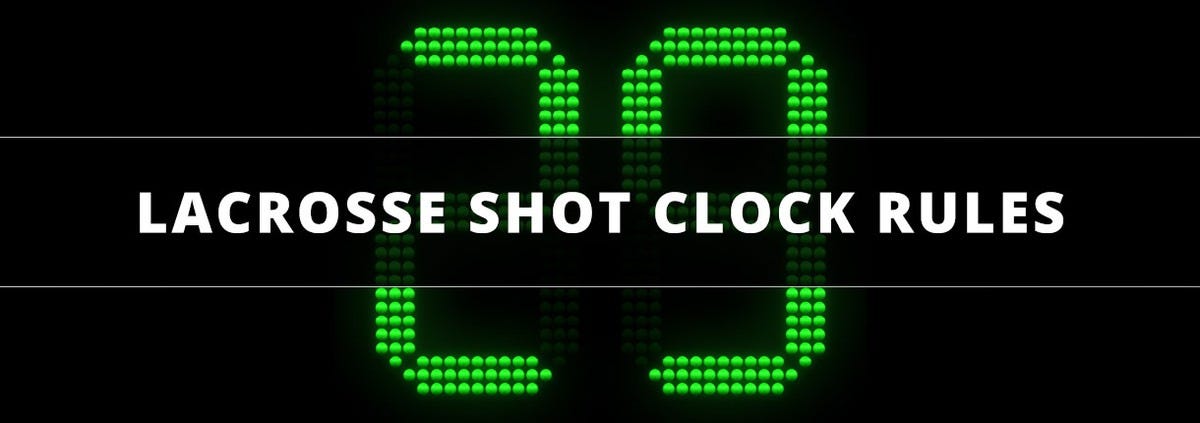A Complete Guide to Lacrosse’s Shot Clock Rules

In men's lacrosse, understanding the shot clock is essential for both players and fans. In this article, we'll delve into the intricacies of the shot clock, addressing its presence and significance in men's lacrosse. We'll explore the shot clock rules, what it means for the game, and potential violations. If you're curious about how this element impacts the sport, you're in the right place. To explore more aspects of lacrosse gear and the game, don't forget to check out our full selection of lacrosse gear. To see more options, check out our full selection of lacrosse gear.
Yes, there is a shot clock in men's lacrosse, and its introduction has been a significant change in the sport. The shot clock was implemented to enhance the pace of the game and encourage offensive action. It ensures that teams take a shot on goal within a specified time frame, preventing them from stalling or holding possession for an extended period without attempting to score. The shot clock has added excitement and strategic elements to men's lacrosse, making it a key component of the modern game.
The shot clock in men's lacrosse signifies a time limit imposed on an offensive team to take a shot on the opponent's goal. It means that once an offensive possession begins, the team has a set amount of time, typically 60 seconds, to release a shot on goal. This rule encourages offensive teams to be more aggressive and proactive, preventing them from stalling or holding possession without making a genuine attempt to score. If a team fails to take a shot within the allotted time, possession is awarded to the opposing team, giving them a chance to initiate their own offensive play. The shot clock has added urgency and strategy to men's lacrosse, promoting faster-paced and more exciting gameplay.
In men's lacrosse, the shot clock is a critical component designed to keep the game fast-paced and engaging. Here are the key rules related to the shot clock timing and its application:
- Length of the Shot Clock: Typically, the shot clock is set to 80 seconds. Once a team gains possession of the ball, they have this time to attempt a shot on goal.
- Resetting the Shot Clock: The shot clock resets to 80 seconds when a team takes a shot on goal that is saved by the goalkeeper or hits the goal frame, and the offensive team regains possession. Additionally, certain infractions by the defending team can lead to a reset.
- Shot Clock on Clears: Teams have a specific time frame (usually 20 seconds) to clear the ball from their defensive half of the field into the offensive half. Failure to do so results in a turnover.
- Stalling Penalties: If a team appears to be deliberately stalling or not actively attempting to score, officials may issue a stalling warning, requiring the team to shoot within a certain time frame, often indicated by a shot clock counting down from 30 seconds.
- End of Period: If the game clock shows less time remaining in the period than the shot clock, the shot clock is turned off, allowing the offensive team to hold the ball for a last shot before time expires.
- Dead Ball Situations: The shot clock is stopped during dead ball situations and typically resumes when the ball is back in play.
- Violations: Failing to take a shot within the allotted time results in a shot clock violation, and the ball is turned over to the opposing team.
These rules ensure a continuous, aggressive play style, discouraging teams from holding the ball excessively and promoting a more dynamic and exciting game for players and spectators alike.
Lacrosse shot clock violations occur when a team fails to take a shot on goal within the allotted time frame, typically 80 seconds in men's lacrosse. When the violation occurs, the ball is turned over to the opposing team. This rule is designed to keep the game moving at a brisk pace, encouraging offensive plays and preventing teams from stalling. It's important for players to be aware of the shot clock time, especially as it winds down, to avoid costly turnovers. Coaches often develop strategies to maximize possession time while ensuring they get a quality shot off before the shot clock expires. Referees will signal the violation, and play is stopped momentarily to allow for the change of possession. Understanding and effectively managing the shot clock is a critical aspect of game strategy and can significantly impact the outcome of a match.
How do you run a shot clock in lacrosse?
Running a shot clock in lacrosse involves starting the count as soon as a team gains possession and closely monitoring the game to pause or reset the timer as necessary. Timekeepers must signal any violations when time expires and work in tandem with referees to ensure the game's flow remains fast-paced and fair. The visibility and accuracy of the shot clock are crucial, as it influences the strategies and urgency of the players throughout the match.
What is the shot clock in women's lacrosse?
In women's lacrosse, the shot clock is a relatively recent addition, intended to speed up the game and encourage more offensive play. It typically gives a team 90 seconds to take a shot on goal once they gain possession of the ball. If the team fails to get a shot off in this time, they commit a shot clock violation, and the ball is turned over to the opposing team. The introduction of the shot clock in the women's game mirrors efforts in the men's game to make play more dynamic and reduce stalling, fostering a faster-paced and more engaging game for players and spectators alike
What resets the shot clock?
In lacrosse, the shot clock can be reset under several circumstances, which generally promote continued, aggressive play. Firstly, a shot on goal that is saved by the goalkeeper or that hits the goal frame and is then regained by the attacking team typically resets the clock. Additionally, certain types of infractions or fouls committed by the defending team can lead to a shot clock reset as a penalty. The exact rules can vary between men's and women's lacrosse and among different leagues and levels of play, but the overarching intent is to encourage continuous, offensive action and prevent teams from merely holding onto the ball to run down time. It's essential for players and coaches to understand their specific league's regulations to effectively strategize around the shot clock.
Is there a shot clock in high school lacrosse?
The use of a shot clock in high school lacrosse varies by state and the governing body of the sport. As of my last update in April 2023, not all states had adopted a shot clock for high school games, with adoption more common in some regions than others. The trend has been moving toward the inclusion of a shot clock to align high school play with college rules and to promote a faster-paced, more engaging game. When implemented, the duration of the shot clock and specific rules about resets and violations can differ from those in college lacrosse. It's important for players, coaches, and fans to check with their local high school athletic associations for the most current rules regarding the use of a shot clock in their area.
Find the Best Selection of Lacrosse Gear at Lacrosse Monkey!
For players looking to elevate their game with the best equipment, Lacrosse Monkey offers an extensive selection of lacrosse gear. From sticks and helmets to pads and apparel, find everything you need to dominate the field in style and safety. We invite you to browse our full selection and gear up with confidence at Lacrosse Monkey today! Browse Our Full Selection of Lacrosse Gear.








